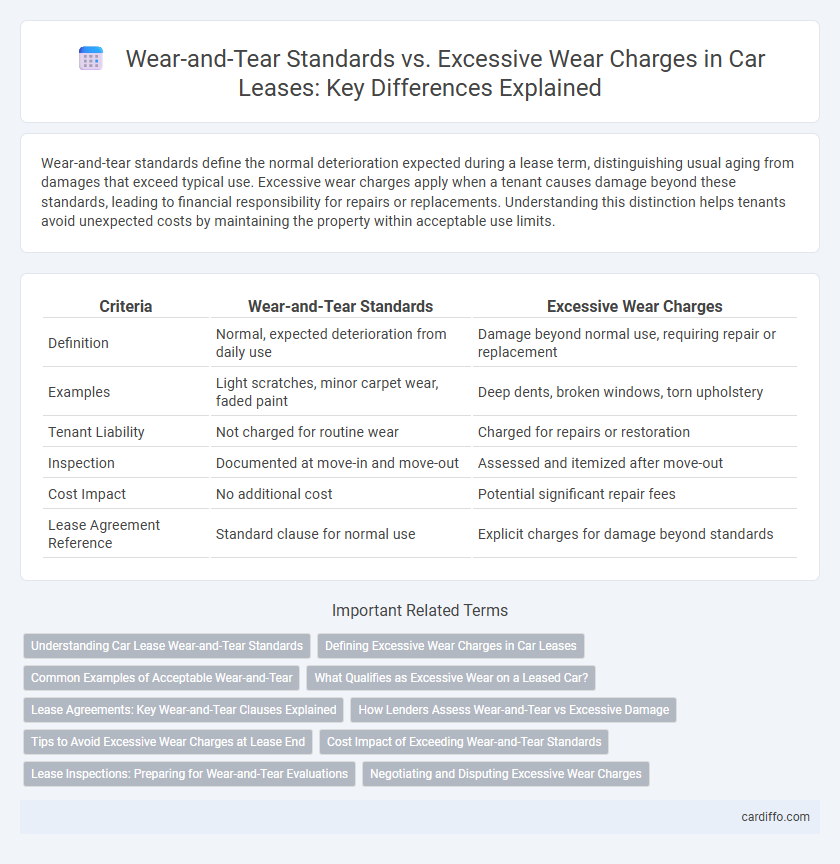Wear-and-tear standards define the normal deterioration expected during a lease term, distinguishing usual aging from damages that exceed typical use. Excessive wear charges apply when a tenant causes damage beyond these standards, leading to financial responsibility for repairs or replacements. Understanding this distinction helps tenants avoid unexpected costs by maintaining the property within acceptable use limits.
Table of Comparison
| Criteria | Wear-and-Tear Standards | Excessive Wear Charges |
|---|---|---|
| Definition | Normal, expected deterioration from daily use | Damage beyond normal use, requiring repair or replacement |
| Examples | Light scratches, minor carpet wear, faded paint | Deep dents, broken windows, torn upholstery |
| Tenant Liability | Not charged for routine wear | Charged for repairs or restoration |
| Inspection | Documented at move-in and move-out | Assessed and itemized after move-out |
| Cost Impact | No additional cost | Potential significant repair fees |
| Lease Agreement Reference | Standard clause for normal use | Explicit charges for damage beyond standards |
Understanding Car Lease Wear-and-Tear Standards
Car lease wear-and-tear standards define the acceptable condition of a vehicle upon return, typically covering minor scratches, dings, and tire wear that conform to normal use. Excessive wear charges are applied when damages exceed these standards, including deep dents, cracked windshields, or interior stains that require costly repairs. Understanding these standards helps lessees avoid unexpected fees by maintaining the vehicle within the parameters set by the leasing company.
Defining Excessive Wear Charges in Car Leases
Excessive wear charges in car leases refer to fees applied when a vehicle's condition goes beyond normal wear and tear as defined by the lease agreement, including damages like deep scratches, dents, and tire wear exceeding specified limits. Lease contracts typically outline detailed criteria for normal wear, such as minor scratches, small chips, or light interior stains, distinguishing them from excessive damage that affects the vehicle's value. Understanding these standards is essential for lessees to avoid unexpected end-of-lease fees and maintain compliance with the lessor's assessment guidelines.
Common Examples of Acceptable Wear-and-Tear
Common examples of acceptable wear-and-tear in leases include minor carpet stains, small nail holes from picture hanging, and slight fading of paint or wallpaper due to sunlight exposure. These conditions reflect normal use and aging of the property without neglect or damage. Landlords typically distinguish such ordinary deterioration from excessive wear charges, which cover repairs like large holes in walls, broken fixtures, or significant carpet damage.
What Qualifies as Excessive Wear on a Leased Car?
Excessive wear on a leased car includes damages beyond normal usage such as deep scratches, dents, broken lights, and torn upholstery, which significantly reduce the vehicle's value. Typical wear-and-tear standards allow for minor scuffs, light scratches, and small chips that do not affect the car's function or safety. Lease agreements often specify detailed guidelines and charge lessees for repairs exceeding these acceptable wear limits to protect the vehicle's resale value.
Lease Agreements: Key Wear-and-Tear Clauses Explained
Lease agreements clearly define wear-and-tear standards to distinguish normal use from excessive wear that may incur extra charges. Common clauses specify acceptable conditions for flooring, walls, appliances, and fixtures, ensuring tenants understand their responsibilities. Property managers use these standards to assess damages fairly and determine if deductions from security deposits apply.
How Lenders Assess Wear-and-Tear vs Excessive Damage
Lenders assess wear-and-tear by comparing the property's condition against industry-established standards, recognizing normal deterioration from regular use. Excessive wear charges arise when damage surpasses these norms, indicating neglect or misuse that reduces the property's value. Detailed inspections and documented damage reports enable lenders to differentiate between acceptable wear and costly repairs required for excessive damage.
Tips to Avoid Excessive Wear Charges at Lease End
Maintaining the leased vehicle within the manufacturer's recommended wear-and-tear standards helps prevent costly penalties often imposed at lease end. Regularly inspecting tires, brakes, and upholstery for damage and addressing minor repairs before returning the car minimizes excessive wear charges. Documenting the vehicle's condition with dated photos and referring to the lease agreement's specific wear criteria supports dispute resolution if charges are contested.
Cost Impact of Exceeding Wear-and-Tear Standards
Exceeding wear-and-tear standards in a lease agreement results in significant cost impacts, often leading to excessive wear charges that surpass normal maintenance fees. These charges can include fees for damages like deep stains, burns, or mechanical failures beyond expected depreciation, which substantially increase the lessee's financial liability. Understanding the distinction between standard wear and excessive wear is essential to avoid unexpected termination costs and protect security deposits.
Lease Inspections: Preparing for Wear-and-Tear Evaluations
Lease inspections assess property conditions by distinguishing normal wear-and-tear from excessive damage, ensuring tenants are not unfairly charged. Detailed documentation, including photos and checklists, is essential for accurate evaluations during move-out inspections. Understanding lease wear-and-tear standards helps tenants prepare and avoid disputes over excessive wear charges.
Negotiating and Disputing Excessive Wear Charges
Negotiating excessive wear charges requires understanding lease terms and documenting the condition at move-in and move-out to differentiate between normal wear-and-tear and damage. Tenants should gather photos, maintenance records, and third-party inspections to support their dispute of charges deemed excessive. Landlords must provide itemized evidence linked to lease clauses, fostering transparent communication to resolve disagreements efficiently.
Wear-and-Tear Standards vs Excessive Wear Charges Infographic

 cardiffo.com
cardiffo.com